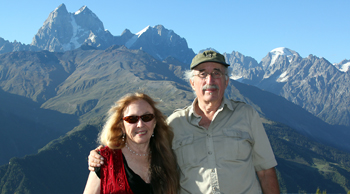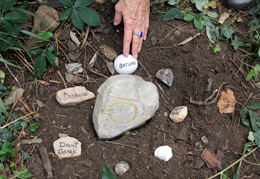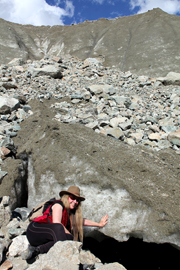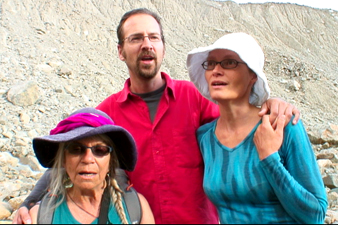 Mount Ushba massif in the Caucasus Mountains of Georgia (P)
Republic of Georgia |
|
|
Dear World Family,
It has been quite a few months since I returned from the Republic of Georgia last fall, and still I hear the voices of my new Georgian friends who are so close to my heart, ringing in my ears. I, and anthropologist, ethnomusicologist and photographer, Peter Gold landed in the middle of the night in Georgia’s capital, Tbilisi. Because of Peter’s early recordings of Georgian village music in 1968, he had been invited by the State Music Conservatory’s International Symposium on Traditional Polyphony to speak about and present his traditional music recordings. Unknown to him before the trip, he was to be honored for his recordings which are prized and now sung by many contemporary choirs and folk ensembles. In addition, most of these wonderful photos of our friends and countryside in Georgia were taken by him. I and some Georgian friends took the remainder. (P)s are by Peter. (V)s are by me. (T)s are by Teo Lomsadze (J)s are by Joseph Jordania.  Vijali Hamilton and Peter Gold in the Caucasus Mountains (J) I was in Georgia to create another World Wheel Project, to respond to the Georgian’s cry for sovereignty. Although Georgia gained her independence from Russia in 1992, Russian troops still hover along their borders, waiting for another excuse to invade. The Georgians are likewise poised with the smell of blood still fresh in their memories from an invasion in 2008 during the South Ossetia war.And, indeed, we fell in love with these vital, creative and over-the-top hospitable people who are, now, not only part of the World Wheel web, a global family, but our very personal family to whom we hope to soon return. Rusudan Tsurtsumia, the most loving and responsive director of the International Research Center for Traditional Polyphony of the Tbilisi State Conservatoire, assigned us the beautiful 25-year-old graduate student, Teo Lomsadze, to be our translator. I can see her open eager face now, smiling and engaged in everything we did. We were fortunate that both the Conservatoire and the US Embassy, through lovely Lola Yaroslava Petrova, its Cultural Attaché, supported our journey with a car, driver and lodging. And to our greatest enjoyment and delight, we were introduced to some of the best folk ensembles and musicologists in Georgia, (including Anzor Erkomaishvili director of Rustavi Ensemble, together with the choirs: Riho, Mzetamze, Basiani, Didgori, Zedashe, Anchiskhati, Elesa), traveling always with music, music, music.
   Lola Petrova (Cultural Attaché of US Embassy (V) Rusudan, Peter, Anzor (V) Teo and Vijali (P)
I love the unknown taking shape before my eyes. And that is what happened as Peter and I and Teo traveled to the four corners of Georgia. One of my favorite journeys was to Svaneti—tucked into the obscure northwestern recesses of the high Caucasus Mountains, where Joseph Jordania, Georgian author and historian of world polyphonic music, invited us along with 30 of his Australian students to study traditional music there with Svanetian choirmasters. It was a day’s journey over winding roads with jutting snowcapped peaks towering above us. We looked down into deep canyons that were formed by melting glacier waterfalls crashing down ravines as their rivers cut into stone and earth. Only in the last three years have the roads been improved enough to not be a hazardous journey. The Svans possess an ancient culture and a dialect that is different from the Georgian language both of which have been preserved due to their isolation. Some Svans and scholars claim that they are related to the ancient Sumerians. The highest villages have never been conquered, even as Georgia’s capital, Tbilisi, was raised and rebuilt 26 times over the centuries. We arrived in a small village outside of the main town of Mestia through a narrow dirt road shared by cows, dogs, chicken and the few large families of the village. Almost every house complex was attached to a medieval stone tower that had been their protection for millennia from invaders, if not also warring neighbors. There, they could seal themselves off behind bolted dungeon-like doors; mama and papa, daughters and sons, with their children and grandparents, cows, bulls, and goats, along with grains and vegetables—all took refuge in the tower, sometimes for months at a time. Only now in the last decade or so have they lived in a state of peace with their neighbors. But you can still taste their warriors’ blood in their songs and dances, with many of their ancient ceremonies and rituals still present in their daily lives.   Lenjeri Village in Svaneti where we stayed with the Pilpani family (P) Father, Son play with Riho ensemble (P) We were privileged to sleep, eat, study, and hike for eight days with the Pilpani family whose grandfather and his son are renowned choirmasters preserving the historical music and instruments of the region.
 Riho ensemble enjoying supra (Georgian feast) & singing with the Pilpani’s (P) Riho ensemble enjoying supra (Georgian feast) & singing with the Pilpani’s (P)Mornings were for studying music with the old choirmaster and afternoons for hiking led by his son, Vakho, exploring the beauty and impeccable ecology of the mountains. One morning we took our lunches with us and drove to the highest permanently inhabited settlement in Europe, named Ushguli, some 2,200 meters in altitude, where we hiked (I hiked with a broken toe on this, my first day out of my surgical boot, wearing hiking shoes). On a long rocky path climbing over boulders we arrived at a glacier slowly receding into the over 17,000 foot high craggy recesses of Mount Shkhara, the highest peak in the Georgian Caucasus.
 Ushguli tower and Mt. Shkhara (P) Touching the crystals of the glacier with my own hands was the trek’s highlight for me, as it was to see the ice’s immediate melting, giving birth to a raging river crashing over boulders, crumbling others into pebbles then into glacier sand. Overhead stones and boulders screamed down the sides of this ice palace, a wall slowly moving as it transformed into a fierce river cutting its canyons millennium after millennium, eventually finding its way down through Western Georgia to the Black Sea as the Enguri River.
After we had eaten our lunches by the glacier, together with a family from Israel who happened to arrive as tourists, I dug a hole into the rock-strewn earth with Teo’s help. From my bag I brought out strips of paper and pens and handed them to the thirty some people who had gathered at the moving mouth of the glacier. I asked them to write their prayers for Georgia, for the peace and freedom that they longed for and well deserved, and prayers for our planet. Peter and Teo helped gather their prayers and I rolled their written voices together into a bundle and placed them as one voice within a jar that I had brought for the ceremony. Then I epoxied the lid on the jar and buried their desires, along with other offerings, to take root in the earth and hearts of the people who happened to be there.   Vijali touching earth altar at glacier (P) Writing prayers for peace and freedom (P)   Putting prayers in bottle (P) Burying prayers in earth altar (P)
Immediately, the circle of voices rising with intent, burst into the tradition song Mravalzhamier, a prayer for long life and happiness, as their voices mixed with the roar of the just birthed glacial river, carrying the hopes and desires of all along with it to the distant Black Sea.
  Joseph Jordania,Vakho Pilpani and friends sing (P) Australian friends deep in song (P) The next ceremony was held in the east of the country. We journeyed to Sighnaghi, a medieval mountain town above the Alazani Valley, full of vineyards. This valley is the center of winemaking in a country that claims to have originated this elixir eight thousand years ago. There we met John Wurdeman, originally from the United States, whose Pheasant’s Tears Winery has helped to resurrect this ancient tradition and chemical-free method of growing the grapes and preparing the wine. As we had been received in every other location on our journey, he provided us a “supra”, a feast in the Georgian style, with wine toasts in their traditional form and course after course after course of the most delicious Georgian dishes, all the while being serenades by his wife’s well-respected musical ensemble, Zedashe.
 Sighnaghi (P)   Earth altar ceremony at Sighnaghi (P) (P)
We also traveled to Georgia’s extreme Southeast on the Azerbaijan border, to Davit Gareja Orthodox Monastery, with its hundreds of cells that have been hewn into the living rock. Saint David, a monk of the Syrian Orthodox order founded the monastic complex in the 6th century AD. You can still feel his presence when you sit in his cave where he lived for decades in meditation. On the outskirts of the monastery where we held a ceremony, a well domesticated black kitten immediately joined us and stayed very attentive and engaged the entire time. It was as if a reincarnated St. David had found a way to join us for that moment while we carried a deep feeling for him from having been in his cave and monastery.
  Vijali in Saint Davit of Gareja’s Cave (P) Earth altar ceremony with attentive kitten (P)
Also, we traveled to Dmanisi, in Georgia’s extreme south, near to the Armenian border. Dmanisi is where Homo georgicus, a Homo erectus, was unearthed. Linking us with our earliest homonid ancestors, we touched the earth where she had lain for 1.9 million years. There, we befriended Dr. Jumber Kopeliani, the man who had raised her from earthy obscurity. I again created ceremony here with the people who happened to be present, offering prayers for the Georgians to live with a free voice and actions expressing their rich and colorful culture.
  Jumber Kopeliani at the site of excavation (P) Jumber, Vijali, Peter with Bronze Age site on hill above (T)
   Teo and Vijali in ceremony (P) Teo and Peter in ceremony (V) Peter singing for ceremony (V) Teo, along with her smile and easy manner was with us on most of our trips, which were places she had never had an opportunity to previously experience. And of course everyone along the way fell in love with her at first sight, as we did and still are:
 Teo (V) Our journey to Georgia’s southwest led us to the semi-autonomous region of Ajara. On our way we stopped at the revered Gelati Monastery. There we experienced magnificent frescos in its church, which were not destroyed as in other churches that we had visited. I was captivated by these ancient stone churches, which still hold the presence of St. Nino who arrived in the 4th century carrying the message of Christ and Mother Mary. Within their thick stonewalls they draw you into a timeless stillness that bypasses nationality, country and age.
  Gelati Monastery Church (P) Interior of Gelati Monastery Church (P)
Before entering the mountains of Ajara we found ourselves at the Black Sea where in ceremony we threw our bottled prayers into its dark waters dreaming where they might be carried and in whose hands they might be found and what language might be breathed upon them.
 Vijali in ceremony at the Black Sea (P)
In the Ajarian hill town of Keda and nearby mountain village of Merisi we met and experienced many of their folk ensembles. We were invited to live a few days in this southwestern corner of the country with a remarkable young man, Badri Tourmalidze and his family, consisting of mother, father, grandmother and his wife and two children. In this predominantly Muslim community we were delighted to see how Christians and Muslims lived harmoniously – often within one family. Badri took us on an exciting jeep ride into the top of the mountains clear up to the border with Turkey. He wanted to show Peter the area in Turkey where he made some of his 1968 recordings. It was a breathtaking trip that we hope to be able to share with our friends in the States this coming autumn, in addition to some of the other regions and people I have mentioned in this newsletter (please contact me if you are interested in joining a small intimate group for a trip to Georgia in the fall 2013: vijali@worldwheel.org)
   Badri and Peter in Ajara on Badri’s trip to the border (V) / Supra (Georgian feast) with Badri center rear (P) / Peter looking toward the border of Turkey (V) Badri and Peter in Ajara on Badri’s trip to the border (V) / Supra (Georgian feast) with Badri center rear (P) / Peter looking toward the border of Turkey (V)
In the midst of our Georgian sojourn the International Symposium on Traditional Polyphony was held at the State Music Conservatoire in Tbilisi whose participants came from all over the world. We also had time to visit the delightful Ketevan Baiashvili, director of the State Museum of Folk Instruments. There we spontaneously danced to old records played in an antique musicbox and knew we were bound to be lifelong friends. At the Symposium, Peter took part in a roundtable discussion that Joseph Jordania led on “New Thinking About Evolution and Expressive Behavior.” I was in the audience and inspired by the discussion, wrote this poem:
Peter was also asked to offer a presentation on his music recording expedition of 1968 in Georgia and among Georgians inside Turkey, and he answered questions about his journey and the communities during those times of Russian occupation. In the days that followed Peter gave two inspiring multimedia talks: “I am the Spirit of the Earth,” on the spiritual and cultural perspectives of Southwestern Native Americans since ancient times, which Georgians were eager to learn about, and “Navajo and Tibetan Sacred Wisdom” describing his published book of the same name.
   Peter, Joseph, Rusudan at Symposium (V) Peter giving slide talk (V) Ketevan Baiashvili at Symposium (V)
One day, we heard a roar outside our window, when we were staying at the Music Conservatoire in Tbilisi, so we went outside and walked one block over to the main avenue. We were immediately caught up in a sea of bodies as they quietly flowed down the street, many wearing bright ultramarine blue T-shirts and carrying banners. I happened to be wearing the same bright blue in a skirt and shawl—and I became one of those beckoning in a new parliament, a new government, a shifting of power from President Saakashvili to Prime Minister Ivanishvili’s “Georgian Dream” coalition. People were walking with a new voice, a new hope, and I was walking with and for them.
Speaking of walking, once when we were traveling we picked up a Christian woman pilgrim and peacemaker from Svaneti who was standing beside the road. Both of us were fascinated with each other’s pilgrimage, which although different in form were similar in spirit. And before our journey was completed we had become friends. The center of our mandala of ceremonies held to the four direction of Georgia, was the capital, Tbilisi. In completion of it, we found a quiet place by the waterfall in the Botanical Gardens on the side of Mtatsminda (“Holy Mountain”), high above the city. I separated creeper-vines to reveal the moist earth spot where a hole was dug for our bottle of prayers to be buried. I placed stones, gathered from the ceremonies in the four corners of Georgia, in a circle around the hole. After burying our prayers consecrated by songs and covering the hole with earth, I placed a stone that I had carved and painted on the front and back with two ancient letters of Georgia’s original alphabet: “An” the first letter of the alphabet, which I chose for the unity of life, the interconnectedness of all things. To live this understanding, I feel, is the only way to live in peace. And on the reverse side was “Don”, the fourth letter for the harmony of the many expressions of life on this planet and for freedom’s voice to rise in each person’s life in order to shape and carry that spark of beauty, which comes from the spirit and vitality inherent in each Georgian person.
   “An,” first letter in ancient Georgian Alphabet (P) “Don,” Fourth letter (P) Mandala of stones from sites (P)
With our journey completed Peter and I flew out from Tbilisi in the middle of the night to return to the States carrying a sadness in our hearts to have to depart from our new family and the beauty of their valleys and mountains and seacoast. But the music that we carried back home soared in our hearts, and is still alive and with us to this day.
Finally, I have a personal desire to return to Georgia and create a “Touchstone for Peace.” It will be a boulder brought down from the Caucasus Mountains, embodying the spirit and strength of Georgia’s people, and will be placed in the center of the capital city. In addition to myself, I will teach children and adults from all walks of life, to carve their symbols of peace on the boulder. It will sit at the center of a site for speeches, theater, music and dance to express the ideas and intent of global peace. What is needed, of course, is the funding and permission. We will see what manifests.
May goodwill arise in the hearts of all, may peace and understanding between people and nations prevail on our Sacred Earth,

Vijali Hamilton, founding director of World Wheel, Global Peace Through the Arts
vijali@worldwheel.org • www.worldwheel.org
|
 Mt. Shkhara with its glacier’s mouth at bottom center (P)
Mt. Shkhara with its glacier’s mouth at bottom center (P)






